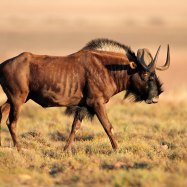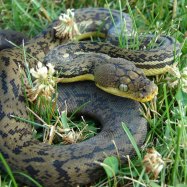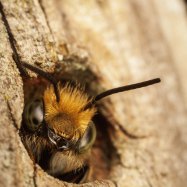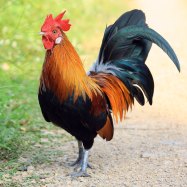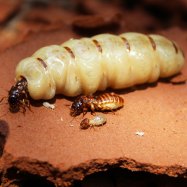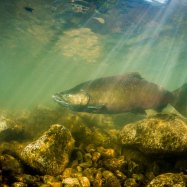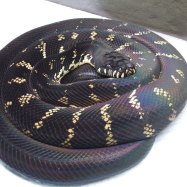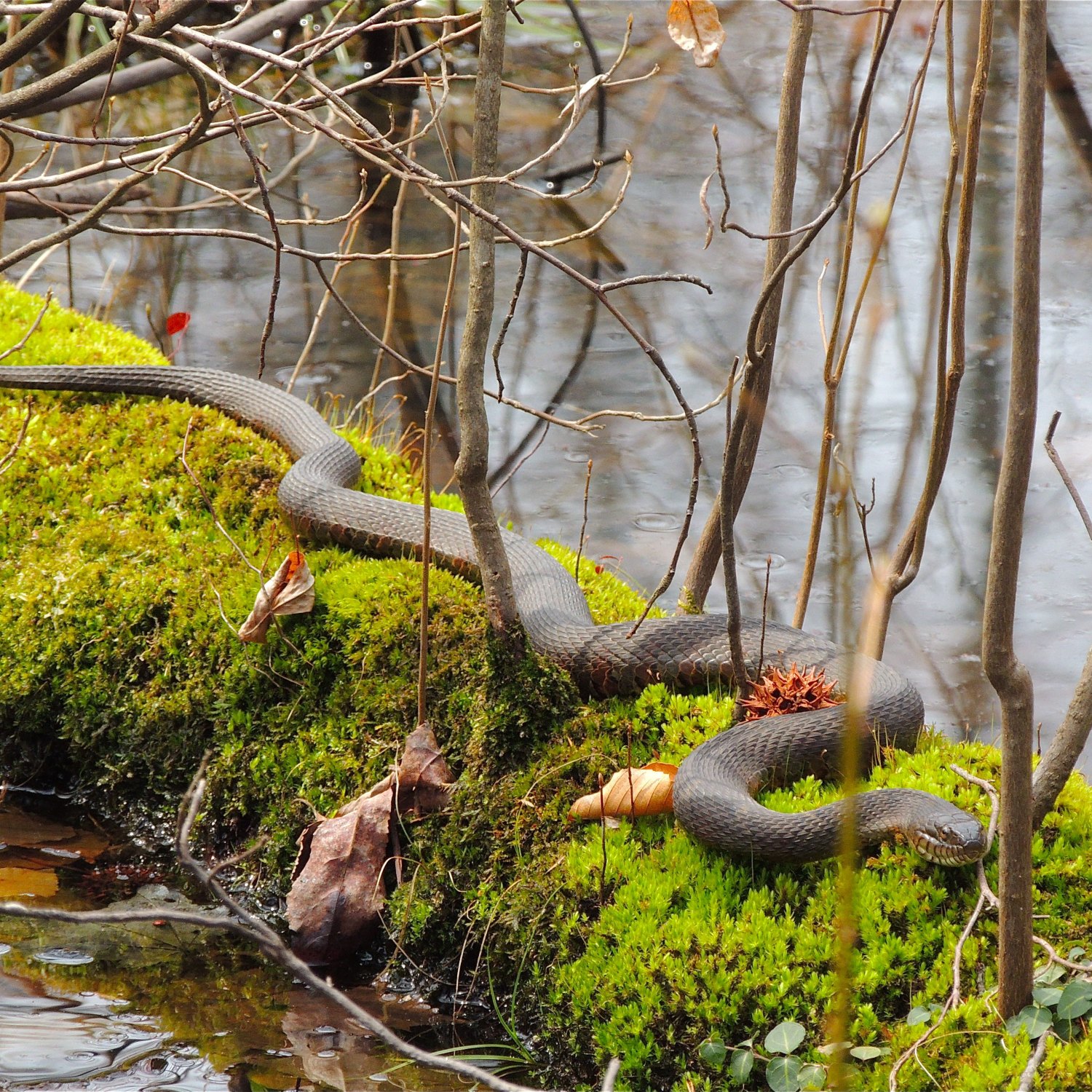
Northern Water Snake
Up to 4.5 feet (1.4 meters)
Meet the Northern Water Snake, a species found in the Northeastern US and central Canada. With a slender, cylindrical body and keeled scales, they can reach up to 4.5 feet in length. Belonging to the Colubridae family, these non-venomous snakes call freshwater habitats their home. Keep an eye out for these fascinating creatures on your next outdoor adventure! #nativewildlife #northernwatersnake #naturelovers
Animal Details Summary:
Common Name: Northern Water Snake
Kingdom: Animalia
Habitat: Aquatic and semi-aquatic habitats such as lakes, ponds, streams, rivers, marshes, and wetlands
The Curious Case of the Northern Water Snake: Exploring the Aquatic Wonders of Eastern North America
Nestled in the Eastern regions of North America, amidst the lush greenery and serene waters, lies a fascinating creature that has captured the interest of many nature lovers – the Northern Water Snake. With its scientific name, Nerodia sipedon, and commonly known as the Northern Water Snake, this reptile has quite a unique set of characteristics that make it a truly remarkable species.At first glance, the Northern Water Snake may seem like your average snake with nothing particularly striking about it. However, upon closer inspection, one can uncover its hidden wonders that make it a truly fascinating creature Northern Water Snake. From its habitat to its feeding method, this article aims to explore the extraordinary features of the Northern Water Snake and how it has adapted to its surroundings in Eastern North America.
The Kingdom of the Northern Water Snake
Before we dive into the details of the Northern Water Snake, it is essential to understand its place in the animal kingdom. The Northern Water Snake belongs to the kingdom Animalia, which comprises all animals with the presence of cells and tissues, making them multicellular organisms.The Phylum of the Northern Water Snake is Chordata, meaning it has a dorsal nerve cord, and its body is supported by a cartilaginous or bony structure. This phylum also includes other animals such as fish, birds, and mammals.
Next is its class, Reptilia, which includes animals with scales, the ability to lay shelled eggs, and cold-blooded. This class spans over 10,000 species, including lizards, crocodiles, and turtles, besides snakes.
The Order and Family of the Northern Water Snake
Moving on to the more specific classifications of the Northern Water Snake, it falls under the order Squamata, which includes over 10,000 species of lizards and snakes. "Squamata" comes from the Latin word, "squama," which means scale Nightjar.From there, the Northern Water Snake's family is Colubridae, which is the largest family of snakes in the world. This family is home to around 304 genera and over 1,600 different species. The subfamily Colubrinae inhabits North America and is where the Northern Water Snake belongs.
Exploring the Habitat of the Northern Water Snake
One of the most intriguing features of the Northern Water Snake is its choice of habitat. As its name suggests, this snake is semi-aquatic and can be found in various aquatic environments such as lakes, ponds, streams, rivers, marshes, and wetlands. It is a highly adaptable species, often found near human settlements, making it a commonly seen snake in yards and gardens.One reason for its preference for aquatic habitats is its ability to swim, thanks to the presence of a fringe of scales on its belly, which provides better traction in water. The Northern Water Snake can also hold its breath for up to 45 minutes and can dive to depths of up to 20 feet, making it an excellent swimmer.
Despite its love for water, the Northern Water Snake is known to bask on rocks or logs near the water's edge to regulate its body temperature. They are also found in wooded areas, where they seek shelter and hibernate during the colder months.
Carnivorous Appetite
The Northern Water Snake is a carnivorous predator, meaning it primarily feeds on other animals to survive. It preys on a variety of creatures such as fish, frogs, salamanders, and other small vertebrates and invertebrates that are commonly found in its aquatic habitats.Its diet is not limited to aquatic animals, as it has been seen feeding on birds, small mammals, and even other snakes. Their feeding method is quite interesting, as they are known for their ability to swallow their prey whole, even animals larger than themselves.
The Northern Water Snake's Range
The geographical distribution of the Northern Water Snake is limited to the eastern part of North America, with its range covering areas in the United States and Canada. It is found in the northeastern side of the United States and central Canada and is one of the most common snakes in these regions.While it may not be found across the entire North American continent, the Northern Water Snake has managed to thrive in its range, thanks to its adaptability and ability to survive in various environments.
The Unique Colors and Patterns of the Northern Water Snake
One of the standout features of the Northern Water Snake is its variable colors and patterns, making it a strikingly beautiful creature. Generally, they have a dark brown to gray body with slightly darker blotches on their back and sides. Some other color variations include shades of red, orange, and even pink, making them a sight to see.The patterns on their scales also vary, with some having darker lines or spots, while others have a solid color. This variability in color and patterns is thought to be an adaptation to their surroundings, allowing them to blend in with their environment and avoid predators.
The Slender and Cylindrical Body of the Northern Water Snake
The Northern Water Snake has a slender and cylindrical body, with a slightly flattened belly, making it an agile swimmer. It is also a non-venomous snake, with sharp, curved teeth used for gripping and consuming its prey.Their body is covered in keeled scales, meaning they have a ridge running down the center of each scale, which provides better grip and traction in water. These scales are also an essential feature for distinguishing the Northern Water Snake from other snake species in its range.
Size Matters: How Big Can a Northern Water Snake Get?
The Northern Water Snake may not be the largest snake in North America, but it can reach impressive lengths of up to 4.5 feet (1.4 meters). However, on average, they grow to around 3 feet (0.9 meters) in length, with females generally being larger than males.This size may not seem very intimidating, especially when compared to other snake species, but the Northern Water Snake's behavior and tendency to defend themselves make them equally formidable creatures.
The Life Cycle and Reproduction of the Northern Water Snake
The Northern Water Snake's life cycle begins in early spring when they emerge from hibernation. Mating season runs from late April to late May, during which males compete for females by exhibiting colorful displays and combat.After mating, the females lay around 7-30 eggs in June or July, which hatch after about two months. The eggs are generally laid near or in the water, and once hatched, the young snakes go on to fend for themselves, with the mother providing no parental care.
These snakes reach sexual maturity at around two to three years of age and can live up to 10 years in the wild.
The Importance of Northern Water Snakes in the Ecosystem
While snakes may not be everyone's favorite animal, they play a crucial role in their ecosystem. The Northern Water Snake is no exception, as it plays a vital role in controlling the population of prey species, maintaining the delicate balance of the food chain.By consuming other animals, the Northern Water Snake helps keep the population of potentially harmful creatures in check, preventing them from becoming overpopulated and causing imbalance in their habitat.
The Northern Water Snake: A Protected Species
Despite being a common snake, the Northern Water Snake is a protected species in most states and provinces within its range. This protection is necessary due to frequent misunderstandings leading to fear and persecution of these snakes.Additionally, loss of habitat and water pollution are also significant threats to their survival. Therefore, conservation efforts and regulations are in place to protect the Northern Water Snake and ensure its survival in the wild.
In Conclusion
The Northern Water Snake may not be the most popular or well-known creature in North America, but its unique features and behavior have made it a fascinating subject of study for scientists and nature enthusiasts.From its habitat to its diet and reproductive methods, the Northern Water Snake has many distinct characteristics that make it a remarkable creature. Its adaptability to aquatic environments, impressive swimming skills, and vital role in the ecosystem make it an essential species in the Eastern parts of North America.

Northern Water Snake
Animal Details Northern Water Snake - Scientific Name: Nerodia sipedon
- Category: Animals N
- Scientific Name: Nerodia sipedon
- Common Name: Northern Water Snake
- Kingdom: Animalia
- Phylum: Chordata
- Class: Reptilia
- Order: Squamata
- Family: Colubridae
- Habitat: Aquatic and semi-aquatic habitats such as lakes, ponds, streams, rivers, marshes, and wetlands
- Feeding Method: Carnivorous
- Geographical Distribution: Eastern North America
- Country of Origin: United States and Canada
- Location: Northeastern United States and central Canada
- Animal Coloration: Variable colors and patterns, ranging from dark brown to gray with darker blotches on the back and sides
- Body Shape: Slender and cylindrical body with keeled scales
- Length: Up to 4.5 feet (1.4 meters)
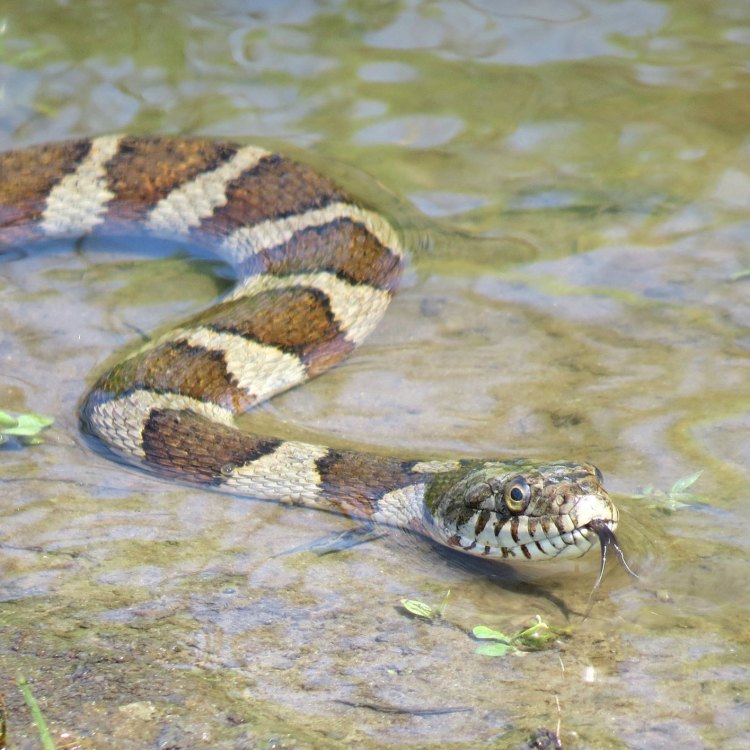
Northern Water Snake
- Adult Size: Average adult size is around 2 to 3 feet (0.6 to 0.9 meters)
- Average Lifespan: 10 to 15 years
- Reproduction: Oviparous (lays eggs)
- Reproductive Behavior: Males engage in combat for mating rights with females
- Sound or Call: Primarily silent, but makes hissing or rattling sounds when threatened
- Migration Pattern: Non-migratory, but may move to find suitable hibernation sites
- Social Groups: Solitary, except during breeding season
- Behavior: Semi-aquatic and spends most of its time in or near water
- Threats: Habitat loss, pollution, overcollection for pet trade
- Conservation Status: Least Concern
- Impact on Ecosystem: Important predator of small aquatic animals, plays a role in controlling populations of prey species
- Human Use: Not commonly used by humans, occasionally kept as pets
- Distinctive Features: Distinctive reddish-orange belly and throat, weakly venomous
- Interesting Facts: Can flatten its body to appear larger when threatened, can swim well and may dive to escape predators
- Predator: Birds of prey, largemouth bass, snapping turtles
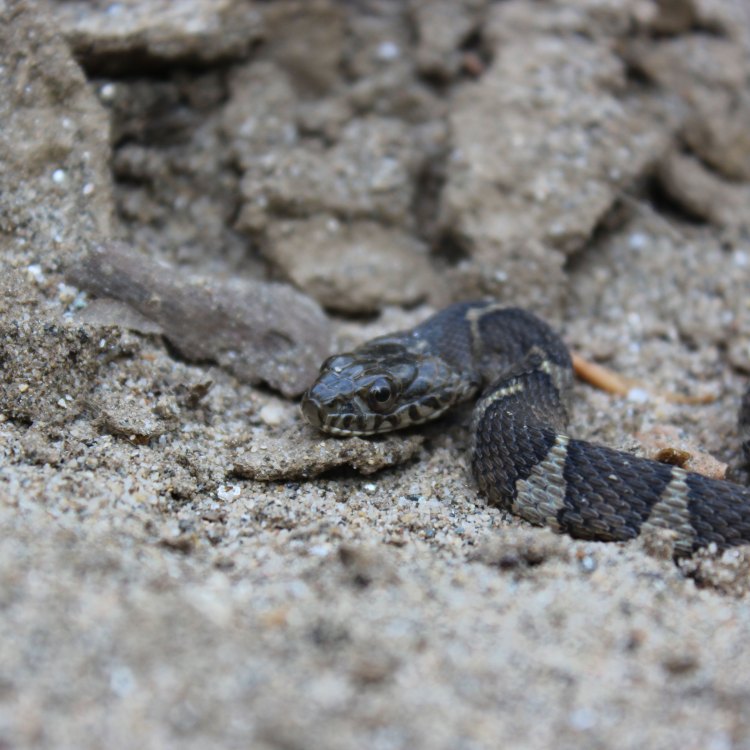
Nerodia sipedon
The Slithery World of the Northern Water Snake
Northern Water Snakes, also known as Nerodia sipedon, are a common sight in North America and can be found near bodies of water such as streams, lakes, and ponds. Often confused with venomous snakes such as the Cottonmouth, the Northern Water Snake is actually a harmless species that plays a vital role in its ecosystem. In this article, we will explore the unique features and behavior of this fascinating snake and its impact on the environment.Adult Northern Water Snakes typically measure around 2 to 3 feet (0 PeaceOfAnimals.Com.6 to 0.9 meters) in length, making them relatively small compared to other snake species. They have an average lifespan of 10 to 15 years, with females being known to live longer than males. Reproduction in these snakes is oviparous, meaning they lay eggs rather than giving birth to live young. These eggs are usually deposited in submerged vegetation or hidden in crevices near water.
During the breeding season, which takes place from late spring to early summer, male Northern Water Snakes engage in combat with each other to win the right to mate with females. This involves intertwining their bodies and pushing against each other, with the stronger male ultimately claiming the female. This behavior can be quite intense and may result in minor injuries to the snakes involved.
While generally silent, Northern Water Snakes may make hissing or rattling sounds to warn predators when feeling threatened Nile Crocodile. These sounds are created by rapidly vibrating their tails against dry leaves or grass, a behavior known as "rattling." However, their primary defense mechanism is to flee or remain still and try to blend in with their surroundings.
Northern Water Snakes are a non-migratory species, but they may move to find suitable hibernation sites during the colder months. They typically hibernate in abandoned mammal burrows, rock crevices, or underwater dens. In the southern parts of their range, they may not hibernate at all and instead remain active throughout the year.
Being solitary animals, Northern Water Snakes spend most of their time alone, except during the breeding season. They are semi-aquatic and are often found in or near water, where they hunt for prey. Their diet consists mainly of small aquatic animals such as fish, frogs, tadpoles, and salamanders. They are also known to prey on other snake species, including their own kind.
These snakes play a crucial role in the ecosystem as predators, helping to control the population of their prey species. This is particularly important for fish populations, as Northern Water Snakes can significantly reduce the number of small fish in a body of water. They also serve as a food source for larger animals such as birds of prey, largemouth bass, and snapping turtles.
However, Northern Water Snakes are facing several threats in the wild. Habitat loss due to human development, pollution in water bodies, and overcollection for the pet trade are some of the major dangers to their survival. As a result, these snakes have been designated as a species of Least Concern by the International Union for Conservation of Nature (IUCN). But conservation efforts are still necessary to ensure their continued presence in the wild.
Despite being weakly venomous, Northern Water Snakes are not considered dangerous to humans. Their venom poses little threat to humans, and they do not have fangs capable of injecting venom deep enough to cause any harm. However, they may bite if threatened or handled, so it is best to admire them from a safe distance.
One of the most distinctive features of the Northern Water Snake is its reddish-orange belly and throat. This coloring is unique among North American snakes and serves as a warning to predators that they are not an easy meal. Another interesting fact about these snakes is their ability to flatten their bodies to appear larger when feeling threatened. This helps to intimidate potential predators, making them think twice before attacking.
In addition to this, Northern Water Snakes are excellent swimmers and can move smoothly through the water using their bodies in a serpentine motion. They have even been observed diving to escape predators, staying underwater for up to 20 minutes at a time.
In terms of human use, Northern Water Snakes are not commonly used or exploited. However, they are occasionally kept as pets by reptile enthusiasts. It is essential to research and understand the care requirements of these snakes before considering keeping one as a pet.
In conclusion, Northern Water Snakes may not be the most glamorous or well-known species, but they play a vital role in their ecosystem and are fascinating creatures. Their distinctive features and behaviors make them stand out among other snake species, and their presence serves as a reminder of the diversity and complexity of the natural world. It is crucial to learn more about these snakes and to take steps to protect and conserve them for future generations to appreciate and admire.
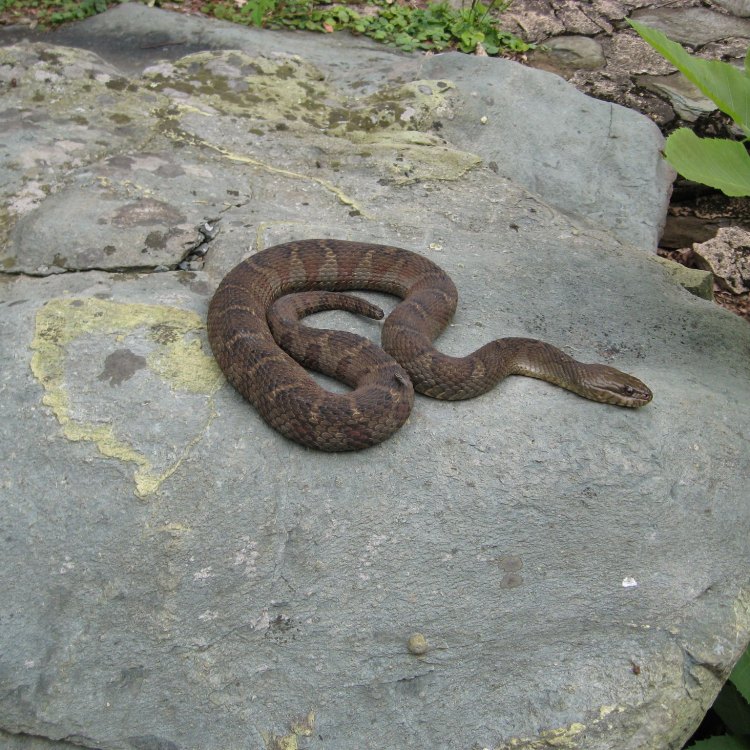
The Curious Case of the Northern Water Snake: Exploring the Aquatic Wonders of Eastern North America
Disclaimer: The content provided is for informational purposes only. We cannot guarantee the accuracy of the information on this page 100%. All information provided here may change without prior notice.



